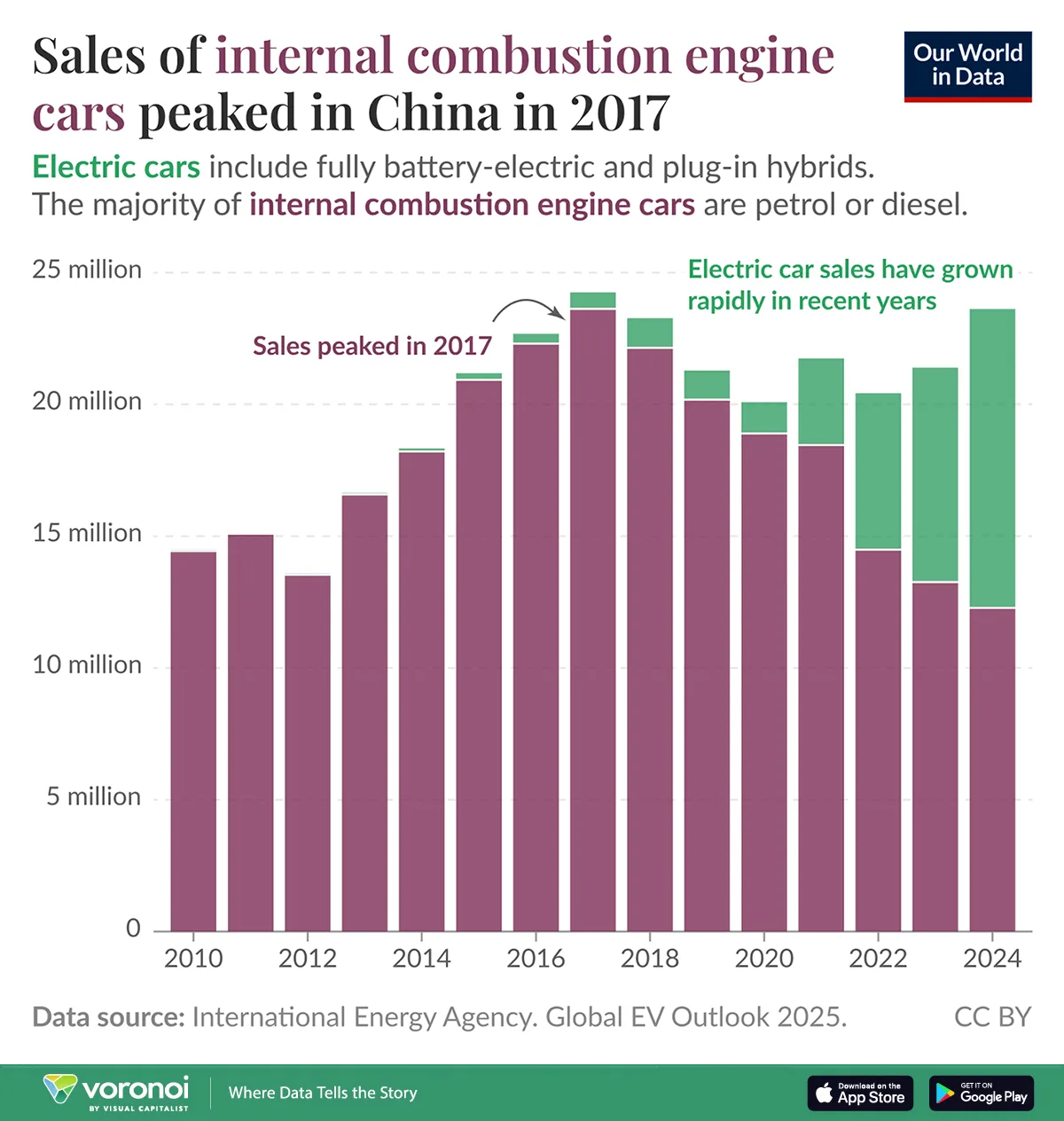![]()
See this visualization first on the Voronoi app.

Chart: Electric Vehicle Sales in China Hit a Major Milestone
This was originally posted on our Voronoi app. Download the app for free on iOS or Android and discover incredible data-driven charts from a variety of trusted sources.
- Sales of internal combustion engine (ICE) cars in China peaked in 2017 at over 24 million units.
- Electric vehicles (EVs) now make up nearly half of all new car sales in the country.
- Government policies, local incentives, and falling EV prices have all contributed to this rapid transformation.
Sales of ICE vehicles in China reached their high-water mark in 2017, topping out at just over 24 million units. Since then, demand for traditional petrol and diesel cars has steadily declined—while electric vehicles (EVs), including battery-electric and plug-in hybrids, have rapidly grown in market share.
This transition is captured in the latest chart from Our World in Data, using data from the International Energy Agency (IEA)’s Global EV Outlook 2025.
Here is a closer look at the data:
| Year | Share of new cars in China that are electric (%) |
|---|---|
| 2012 | 0.1 |
| 2013 | 0.1 |
| 2014 | 0.4 |
| 2015 | 1 |
| 2016 | 1.5 |
| 2017 | 2.4 |
| 2018 | 4.7 |
| 2019 | 5 |
| 2020 | 5.7 |
| 2021 | 15 |
| 2022 | 29 |
| 2023 | 38 |
| 2024 | 48 |
As shown above, ICE car sales have declined from their 2017 peak, while electric vehicle sales have grown sharply, especially since 2021. In 2024, EVs were projected to account for nearly 48% of all new cars sold in China.
China’s Rapid EV Adoption, Explained
The question then becomes: how did China achieve this dramatic shift in less than a decade? Multiple factors played a role:
- Government support: Aggressive subsidies and quotas helped jumpstart the EV industry.
- Local incentives: Cities like Shanghai offered perks such as free license plates for EVs.
- Battery dominance: China became a global hub for battery manufacturing, reducing costs.
- Improved infrastructure: China now has more EV charging stations than any other country.
Additionally, as explored in our previous post Why EVs Are Now Cheaper Than Gas Cars in China, lower upfront prices have helped EVs outcompete traditional vehicles on cost alone.
What Comes Next?
While nearly one in two new cars sold in China is now electric, the question remains whether the country will hit a further inflection point in the near future.
The IEA forecasts that EV adoption will continue to grow, though at a slower pace as market saturation approaches in major urban areas. Emerging challenges include:
- Stalling demand in rural regions with less charging infrastructure
- Increased competition among domestic and foreign EV makers
- Policy adjustments as subsidies wind down
Still, China remains a dominant force in the global EV market, accounting for 60% of all EV sales worldwide. Its trajectory will likely shape global trends for years to come.
Learn More on the Voronoi App
Explore more insights in our related post on Voronoi: The World Will Have 234 Million EVs by 2030.